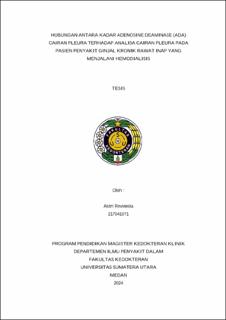| dc.contributor.advisor | Ginting, Ananda Wibawanta | |
| dc.contributor.advisor | Nasution, Bayu Rusfandi | |
| dc.contributor.author | Revinesia, Astri | |
| dc.date.accessioned | 2025-03-06T02:43:31Z | |
| dc.date.available | 2025-03-06T02:43:31Z | |
| dc.date.issued | 2024 | |
| dc.identifier.uri | https://repositori.usu.ac.id/handle/123456789/101833 | |
| dc.description.abstract | Background. Pleural effusion is the accumulation of fluid in the pleural cavity due to an imbalance between fluid production and absorption, with various etiologies including infection, malignancy, and systemic diseases. Chronic Kidney Disease (CKD) is characterized by an irreversible decline in kidney function, increasing the risk of cardiovascular disease and pulmonary complications, including pleural effusion. In Indonesia, pleural effusion accounts for 2.7% of respiratory tract infection cases. The incidence of CKD varies across countries, with a prevalence of 0.38% in Indonesia. Approximately 60% of CKD patients undergoing hemodialysis experience pulmonary complications, including pleural effusion. The diagnosis of pleural effusion is established through clinical examination, radiology, and pleural fluid analysis, with the classification of transudate or exudate determined using Light's criteria. Adenosine deaminase (ADA) has been used as a biomarker to detect pleural effusion due to tuberculosis, particularly in endemic regions. Objective. To determine the relationship between ADA levels in pleural fluid and pleural fluid analysis in hospitalized chronic kidney disease patients undergoing hemodialysis. Methods. This study is an observational analytic study with a cross-sectional design using medical record data. Bivariate analysis was performed to assess the relationship between pleural fluid analysis and ADA levels in pleural effusion fluid among hospitalized CKD patients with pleural effusion using the Chi-Square statistical test. The strength of the relationship between the independent and dependent variables was assessed using a contingency correlation test due to the different scales of both variables. Statistical analysis was conducted using SPSS version 26. Results. The analysis of the relationship between ADA levels in pleural fluid and pleural fluid analysis in hospitalized chronic kidney disease patients undergoing hemodialysis yielded a p-value of 0.023. Based on the Chi-Square test, the analysis of the duration of hemodialysis with ADA levels resulted in a p-value of 0.154 (p<0.05). Conclusion. There is a relationship between ADA levels in pleural fluid and pleural fluid analysis in hospitalized chronic kidney disease patients undergoing hemodialysis. | en_US |
| dc.language.iso | id | en_US |
| dc.publisher | Universitas Sumatera Utara | en_US |
| dc.subject | ADA | en_US |
| dc.subject | Pleura | en_US |
| dc.subject | CKD | en_US |
| dc.subject | Hemodialysis | en_US |
| dc.title | Hubungan antara Kadar Adenosine Deaminase (ADA) Cairan Pleura terhadap Analisa Cairan Pleura pada Pasien Penyakit Ginjal Kronik Rawat Inap yang Menjalani Hemodialisis | en_US |
| dc.title.alternative | Relationship between ADA Levels in Pleural Fluid and Pleural Fluid Analysis in Hospitalized Chronic Kidney Disease Patients Undergoing Hemodialysis | en_US |
| dc.type | Thesis | en_US |
| dc.identifier.nim | NIM217041071 | |
| dc.identifier.nidn | NIDN0003128601 | |
| dc.identifier.nidn | NIDN0014058502 | |
| dc.identifier.kodeprodi | KODEPRODI11103#Ilmu Kedokteran Klinis | |
| dc.description.pages | 98 Pages | en_US |
| dc.description.type | Tesis Magister | en_US |
| dc.subject.sdgs | SDGs 3. Good Health And Well Being | en_US |


